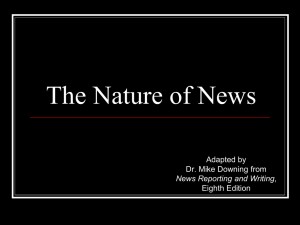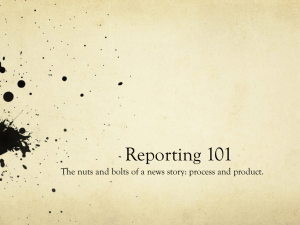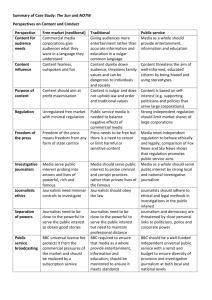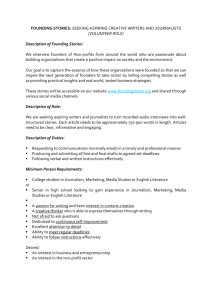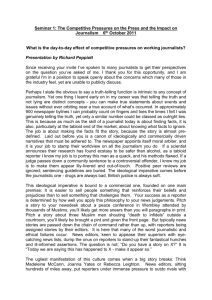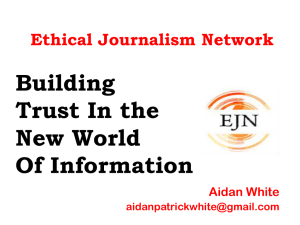Analysis of news gathering and distribution essay Scarlet James 2012
advertisement
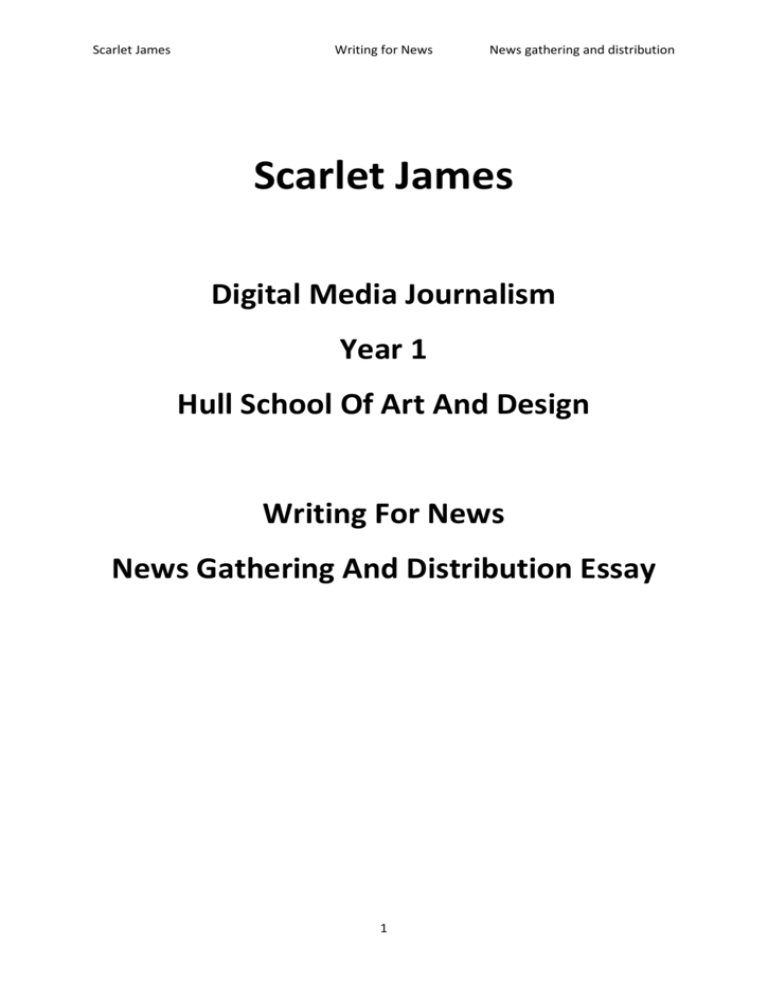
Scarlet James Writing for News News gathering and distribution Scarlet James Digital Media Journalism Year 1 Hull School Of Art And Design Writing For News News Gathering And Distribution Essay 1 Scarlet James Writing for News News gathering and distribution Analysis of news gathering and distribution essay In this essay I shall be looking at how news gathering and distribution has changed in recent years, due to changes in the demand of accessibility and the digital revolution. By investigating the tools which are used to gather and distribute news and the effects this is having on journalism, As consumers of today we don't simply wait for the paper to arrive at our front door or wait for a news bulletin on the television like we used to. In most cases in today's society we use the technology that is available to us. Digital changes have made news in current times very different in comparison to 10 years ago, but what will this mean for the media in terms of Professional journalists? The Internet is currently a main source for news so I will explore this and how news is gathered to publish online. I will be looking at how News companies are surviving through this digitalisation and the tactics they are using to stay in business. In 2005, newspapers in America made $49,435 million in total revenue, which was the highest it had been 2 years previous, But from 2006 the revenue made in print has declined rapidly, falling from $49,275 million to a staggering $23,941 million in advertisement revenue. Meaning 7.3% in losses in 2011 and 6.3% in 2010[ As shown in Figure 3 and 4]. According to these figures from stateofthemedia.org shows advertisement revenue to half of what it was back in 2006. Their study into the state of the newspaper industry despite losses in revenue, shows figures of newspapers in circulation in this time period has remained fairly similar, with a slight decrease in the last year or so. This study gives evidence that the problem in journalism is not the size of the audience but solely the advertisements. This is partly due to the audience changing the platform they consume their news. The traditional methods of gathering news are still being used today, such as journalists going out to find news where they can by interviewing people, members of communities, Law journalists for example going to court to hear verdict of various crimes and offences, those who work in specific fields to find news stories, which are in the interest of the public. Other ways of gathering news is through council press releases and members of public contacting companies to share what they believe to be a potential news story. However more people are consuming news through online sources then print, meaning the media industry is having to adapt to digital growth, resulting in advertisements also following suite, being a heavy internet user, I can most certainly see the increase in advertisements online, but clearly from this data the revenue made in online advertisements is significantly cheaper to produce and publish online. Distribution of News is no longer available at certain times of the day, such as when their paper is delivered to them first thing in the morning, on the newsstand on the way to work or 6 o'clock when generally people relaxed at home . News distribution through newspapers, magazines and broadcasting sectors used to play the largest part in getting news stories out to the public but just like how news is gathered, it has revolved with the use of social media and the use of the internet. So who is the main culprit of these changes? The emergence of the internet and particularly in the form of social media and blogs. ,Meaning how we gather and distribute news has is evolving. Figure 1 is a chart showing the changes of print in circulation from November 2000 to 2009. The chart shows the national papers in the print industry and the changes in circulation. From this, we 2 Scarlet James Writing for News News gathering and distribution can see that some newspapers have not varied in numbers, possibly due to the size of the paper, content and price. There is defiantly changes in certain print publications figures which mostly have decreased in numbers distribution, which could be most defiantly be linked with the technology growing and access to free online journalism, created by national papers maybe to attract a wider audience or amateur journalists who upload news stories, images and videos online for the world to see. Figure 1. [http://www.guardian.co.uk/media/2009/dec/14/national-newspapers-sales-decade accessed March 2012] How people get their news has evolved due to the digital revolution, meaning that news is more available now than it has ever before, broadcasted news is now available not just as prime times of the day but through 24-hour news channels, with constant updates and news coverage. The internet has revolutionized the media without a doubt with ability of instantly uploading data such as images and videos and instant access. The internet has allowed anyone with internet access the ability to share and create news. There are many ways that you can use the internet to access news stories such as YouTube, Social media sites such as Facebook and Twitter, personal blogs, National papers websites and broadcasters websites. The internet has also brought us news aggregator which is a online archive bringing stories from thousands of news websites into one place, websites such as Google reader, feedly.com, popurls.com and reddit.com are great for sourcing a particular story but to also get a insight from another reporters perspectives. These kind of online news sourcing do not have reporters and photographers to find a story as they purely collect news, which means news organisations are still getting their stories out to the audience even if it is not directly to their own website. 3 Scarlet James Writing for News News gathering and distribution Social media is also a new player in the distributed and gathering of news, with people accessing the internet and sharing information as it happens. This is currently playing a large part in the distribution of news, with large numbers of people using social media on a personal and professional level. Social media websites like Twitter, My_space and Facebook is great way of communicating with the digital audience. Twitter has transformed considerably from local communities between people giving updates of what is going on locally for news and gossip. Twitter allows you to 'follow' various people from the public to those in the spotlight (celebrities). Twitter is very important as it posts news events such as the shooting of Osama bin Laden, Which was published online before the major national newspapers and broadcasters knew anything about it. This was due to someone tweeting about the event as it was happening with a final tweet saying the name of who had been shot, creating a news story and reports within minutes. This was then picked up by the papers and broadcasters to then report the findings, this in affect is a new form of news gathering. The twitter feeds are shown in figure 2 Figure 2 [http://newsfeed.time.com/2011/05/02/man-live-tweets-u-s-raid-on-osama-bin-laden-withoutknowing-it/ accessed March 2012] A free flow of information available to you wherever you are. For this to work successfully you must have internet access available, whether it is through broadband, GPRS or 3G. Without this technology, news distribution online to the masses would not have been possible. it is a major advancement for the digital era to succeed, many believe that the wide spread availability of the internet has changed to course of journalism and most certainly had a knock on effect to the way that news is distributed as well as gathered. At the 140 characters, conference titled 'Twitter as a News gathering tool which happened June 2009 with a panel of media professionals one said 4 Scarlet James Writing for News News gathering and distribution "Social media was changing the media landscape because the actual news is now coming from citizens versus journalists."[Quote taken from http://thenextweb.com/2009/06/16/twitter-newsgathering-tool/ accessed April 2012]Although this statement is true in the respect that there are the professional journalist then there are the amateur's or members of public who are also distributing news, but each gather news or potential news from each other, Just like in the case of the Osama bin laden twitter feed, without this, News corporations would of never of got hold of the news story. Until an official press release is given, by government officials. News via blogging and social media is gaining a larger audience now than it has in previous years due to the growing numbers using the internet to search for information. These formats are not just being used by the general public for sharing information whether it is bad or good, but there appears to be a growing trend in large news distributors and broadcasters such as the BBC to share news quicker and more directly, but also allowing them to interact with their audience on a wider scale. Not to say that in the last decade or so that this has not been possible but rather than just writing in which could be a time consuming task or ringing in which could be costly, those who have access point to the internet are able to swiftly communicate back with the broadcasters through social media. Meaning that audience feedback is instantly sending it to the broadcasters, which is great for debate if on a television show they are discussing something live. Social media has also allowed news companies to gain information from the audience by asking for information on a story or if someone has a story to tell to contact them, via twitter Facebook or email. Hulls local BBC news program Look North uses social media sites like Twitter and Facebook to distribute and gather resources for new news stories. They suggest daily to their listeners on BBC radio Humberside as well as their Television broadcasts to get in touch Via the use of these websites, as It not only gives the public a chance to share anything that they think is news worthy, but for them to interact with their audience by reading out their opinions on a story. "For BBC News, social media currently has three key, highly valuable roles in our journalism: • newsgathering - it helps us gather more, and sometimes better, material; we can find a wider ranges of voices, ideas and eyewitnesses quickly • Audience engagement - how we listen to and talk to our audiences, and allowing us to speak to different audiences - and • a platform for our content - it's a way of us getting our journalism out there, in short form or as a tool to take people to our journalism on the website, TV or radio. It allows us to engage different and younger audiences." [http://www.bbc.co.uk/blogs/theeditors/2011/09/ibc_in_amsterdam.html Accessed April 2012] These main points they have listed on their website show that some news corporations like the BBC do not find objection the introduction of social media , but use it as a fundamental tool to keep the viewers who are adapting with the digital era interested in their news reports. This Also gives viewers the ability to talk/ debate about news stories amongst themselves on these social media sites. 5 Scarlet James Writing for News News gathering and distribution The newspaper model has had to adapt through the years, although companies have kept to their original model of print, they also now offer online equivalent's not just on personal computers but on mobile devices such as ipad, Iphone and tablets which has allowed this access to other adaptations of the newspaper model. Although people are accessing news more than ever through online access ,this does not necessarily mean that news corporations are making more money. This is due to the revenue made through advertisements. (Percentages of advertisements, which make up the newspaper) Online this is a completely different situation because of the revenue created from them is much less (figures of money made through advertisements online) so can the newspaper model survive through this digital change and will we still this model in another decade? Many newspapers have had to make sacrifices to avoid distinction, by changing from daily newspapers to by weekly. This is due to the amount of newspapers been in circulation and the amount sold. But how can newspapers and magazines protect their content? By not making so much information available so freely on their websites. Many news publications websites have a brief summary of a story or not allow you to read the entire story but offer the user the change to pay for a subscription to access a E edition of their publication and for extra online features and stories which may not appear in the daily paper, due to a new story breaking out after the print had been printed and distributed. Distribution of news has changed noticeably due to these changes especially because anyone is able to distribute news online, suppressing the power and ideologies of a corporate news company who last decade had control over a large percentage of news distribution in the UK ( reference to news international and the percentage of control of news coverage they have in the UK) and global company Google appears to have a lot of control over many commonly used internet features such as YouTube which is used for those who like film their own blog videos or watch those of others who are sharing news and information within the media industry. Google has been able to control the advertisements that feature on websites such as YouTube ect based on what you have viewed, this manipulation is done by the Google chrome internet browser, not only this they are manipulating their users who use their world dominating search engine with rank control which some may see as a political strategy to manipulate or for financial gain. In the media how news is distributed in different ways depends on the platform, meaning that some forms of news is not compatible on these other platforms. Making it very important that material is constructed correctly for its purpose. But what are the required materials for these different platforms? Producing news content on various different platforms requires various qualities Print for example can be adapted onto web quiet easily "The basis for all news writing is the inverted pyramid, with it mandate to put the most information at the top of a printed story" [ Stephen Quinn, Focal Press 4th Oct 2005 pg 70 kindle] but on another platform such as Broadcast Journalism, the story needs to transformed to be compatible for television news, "In the past, Journalists wrote for one branch of Journalism at a time. Broadcast journalists use different rules than print journalists for writing" [Stephen Quinn, Focal Press 4th October 2005, pg 70 kindle] Some content in news for radio, you would not be able to use content in broadcasting such as video clips, as the audience would not be able to view. Unless it was converted and well-suited for radio, so that the audience can follow the story without confusion. But with the emergence of media 6 Scarlet James Writing for News News gathering and distribution through the use of the Internet, news from these different fields can be brought together "Print, still images, sound, moving pictures, and animation can all be used to tell the same story In a way that wasn't possible before the advent of the web"[Stephen Quinn, Focal Press 4th October 2005, pg 70 kindle] But not everything you find on the web is safe to use across the board of Journalism. Social media, As I have spoken about in the previous section, Can have its uses for journalists, whether that is in broadcasting, radio or print but can all stories you find online safe to use? The problem with user generated content can be whether the statement is true or not, Take figure 2 I have spoken about previously, without conformation that this has actually happened through a reliable source, Journalists have to use their contacts to confirm such a story. As a broadcaster If you was to have video footage which backed up the statement or a photograph, this would be different as it would be clear proof. But publish or broadcast without any evidence to back the statement up, can cause legal problems for the Journalist. So it is very important, in whatever field you specialise in, in Journalism to back up your story to ensure it is correct. The BBC's techniques of finding news stories are quite traditional methods in journalism, By "going out and about, blogs, social media, council agendas, freedom of information, The internet, monitoring all the other news organisations to check that you haven't missed anything, little lines and adverts can spark off a news story, going back and revisiting stories, relying on your contacts in the hope they will give you exclusive stories and ring emergency services or crown prosecution" are all important factors to consider when looking for a news story.[Emma Massey- 2012 talks at Hull college] These are vital techniques not only in Broadcasting but in print too, for example a court reporter at The Hull Daily Mail uses very similar techniques to gather information for stories "Going into court asking them information about the case before a trial" [ Nicky Harley 2012 talks at Hull college]is important in not just building up contacts, as people will get to know your face but you may be given information which no one else has. But generally speaking of journalism, these days, you need to have a wide range of skills to be successful. According to BBC's job requirement page's there are a vast range of skills required to become a broadcast Journalist , ranging in skills "To find and research news stories and programme items. To write voice pieces, bulletins and programme items, exercising editorial judgement, maintaining professional standards and sticking to BBC editorial policies. To interview and report, in both recorded and live situations, in the studio or on location. To prepare and present bulletins for local TV and radio." [http://www.bbc.co.uk/jobs/jts/job-description.shtml accessed April 2012] being some of the qualities expected to be a professional. As a Broadcast journalist I can imagine It much be hard work being a one man band, "A recent study found that while journalists supported the company's new online strategy in principle, they opposed it in practice, or certain of its outcomes"[Bob Franklin Pulling newspapers apart: Analysing print Journalism pg 26 Routledge 1 edition 7th March 2008] Times are changing meaning they are not just expected to achieve these requirements but they are commonly expected to not just present the news in front of a camera, they are expected to work a camera, in the sense of setting up with a tripod, ensure sound levels are substantial, that the lighting is correct, as well as filming various shots to make the piece interesting and film themselves. In conclusion from my findings, It is clear that to work in the Journalism profession you must be able to perfect more than one platform, as generally you are likely to be working over a field."The Broadcast journalists needs to be sufficiently multi-skilled to move around the industry" [Broadcast Journalism: A Critical Introduction Jane Chapman, Marie Kinsey pg4 Routledge;1 edition 28 Oct 2008] You certainly need to be concise, reliable, hard working, be able to gather and construct news 7 Scarlet James Writing for News News gathering and distribution to be read, heard and viewed by the public. The convergence of mediums on the Internet has meant that journalists need to work on various platforms which require some skill, which could most defiantly back up many people's ideology that Journalism will transform to the digital form leaving its predecessor print behind. However I do not think print will vanish all together, but the minority of news distribution, with radio and broadcasting following. This is due to the fact that now you can watch news clips online, Listen to Podcasts, Read news reports online and even create news yourself through blogs and social media. Figure 3 [http://stateofthemedia.org/2012/newspapers-building-digital-revenues-proves-painfullyslow/newspapers-by-the-numbers/ Accessed April 2012] Figure 4 8 Scarlet James Writing for News News gathering and distribution [http://stateofthemedia.org/2012/newspapers-building-digital-revenues-proves-painfullyslow/newspapers-by-the-numbers/ Accessed April 2012] Bibliography Books [ Stephen Quinn, Focal Press 4th Oct 2005 pg 70 kindle] [Broadcast Journalism: A Critical Introduction Jane Chapman, Marie Kinsey Pg 4 Routledge;1 edition 28 Oct 2008] [Bob Franklin Pulling newspapers apart: Analysing print Journalism pg 26 Routledge 1 edition 7th March 2008] Note References [Emma Massey- 2012 talks at Hull college] [ Nicky Harley 2012 talks at Hull college] Website References [http://www.guardian.co.uk/media/2009/dec/14/national-newspapers-sales-decade accessed March 2012] [http://newsfeed.time.com/2011/05/02/man-live-tweets-u-s-raid-on-osama-bin-laden-withoutknowing-it/ accessed March 2012] ."[Quote taken from http://thenextweb.com/2009/06/16/twitter-news-gathering-tool/ accessed April 2012] [http://www.bbc.co.uk/blogs/theeditors/2011/09/ibc_in_amsterdam.html Accessed April 2012] [http://www.bbc.co.uk/jobs/jts/job-description.shtml accessed April 2012] Word count: 3,275 9

